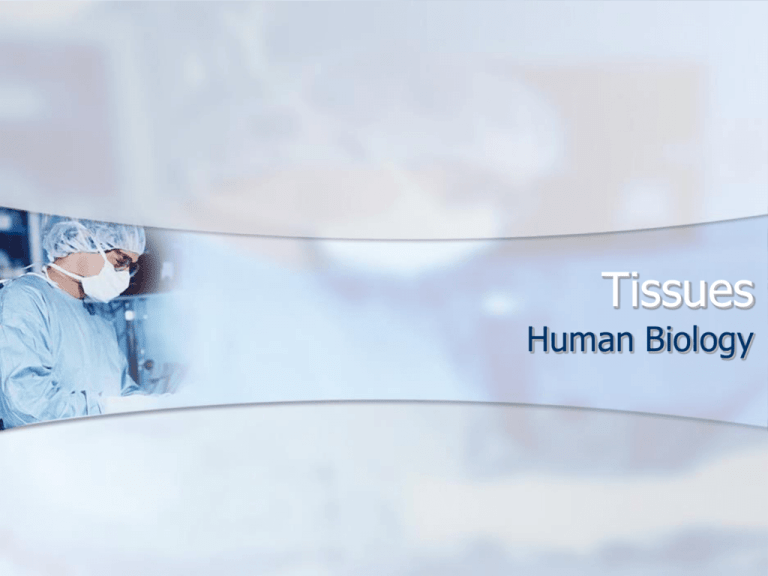Tissues
advertisement

Tissues Human Biology Tissues Groups of cells that are specialized in function or structure Epithelial Connective Muscle Nervous Epithelial Tissue Cover all body surfaces Line all organs Major part of glands Have “free” outside Tightly packed cells Functions: Lining, sensory, secretion, absorption, excretion Definitions Squamous Cuboidal Cube shaped Columnar Think “squat” flattened cells Elongated cells Stratified “Layered” Epithelial Tissues Types Make a table in your notes like this: (8 X 3) Epithelial Type Location (lining) Function Simple & Stratified Squamous Tissue Simple Squamous Tissue Stratified Squamous Tissue Epithelial Type Location (lining) Function Simple Squamous Air sacs of lungs, blood vessels lubrication Stratified Squamous Skin, mouth... protection Simple Columnar Pseudostratified Columnar Stratified Columnar Simple Cuboidal Stratified Cuboidal Transitional Simple & Stratified & Pseudostratified Columnar Tissue Simple Columnar Tissue Pseudo-Stratified Columnar Tissue Simple & Stratified Cuboidal Tissue Stratified Columnar Tissue Epithelial Type Location (lining) Function Simple Squamous Air sacs of lungs, blood vessels lubrication Stratified Squamous Skin, mouth... protection Simple Columnar Stomach, intestines, uterus Trachea, fallopian tubes Vas deferens, male urethra Protective, SA, secrete mucus Pseudostratified Columnar Stratified Columnar Simple Cuboidal Stratified Cuboidal Transitional movement Support & some movement Simple & Stratified Cuboidal Tissue Simple Cuboidal Tissue Stratified Cuboidal Tissue Epithelial Type Location (lining) Function Simple Squamous Air sacs of lungs, blood vessels lubrication Stratified Squamous Skin, mouth... Simple Columnar Stomach, intestines, uterus Trachea, fallopian tubes Vas deferens, male urethra Ovaries, kidneys, thyroid glands Lunrication, protection Protective, SA, secrete mucus Pseudostratified Columnar Stratified Columnar Simple Cuboidal Stratified Cuboidal Transitional Mammary glands, sweat glands, movement Support & some movement Secretion & absorption Secretion & absorption & protections Transitional Tissue Transitional Unstretched Stretched Epithelial Type Location (lining) Function Simple Squamous Air sacs of lungs, blood vessels lubrication Stratified Squamous Skin, mouth... Simple Columnar Stomach, intestines, uterus Trachea, fallopian tubes Vas deferens, male urethra Ovaries, kidneys, thyroid glands Lunrication, protection Protective, SA, secrete mucus Pseudostratified Columnar Stratified Columnar Simple Cuboidal Stratified Cuboidal Mammary glands, sweat glands, Transitional Bladder movement Support & some movement Secretion & absorption Secretion & absorption & protections Stretch, protection against seepage Tissue Identification Tissue Identification Cuboidal Squamous Epithelial Tissues Concept Map Columnar Transitional What are tissues? Groups of cells that are specialized in function or structure What are the four types? Epithelial Connective Muscle Nervous Connective Tissue Fucntions “connects” substances Protect Act as frame Fill spaces Produce blood Repair tissue damage Connective Tissue Make a table in your notes like this: (7 X 3) Connective Tissue Location (lining) Type Function Connective Tissue Types Loose Fibrous Contains elastin Connects skin to organs Provides blood vessels to skin Fills muscle gaps Connective Tissue Location (lining) Type Function Loose Fibrous Nourishment, stretch Under skin, in muscle Connective Tissue Types Adipose Similar to loose fibrous Contains fat storage Insulation, cushions joints, energy reserve Fat droplet Connective Tissue Location (lining) Type Function Loose Fibrous Under skin, in muscle Nourishment, stretch Adipose Spaces throughout body Insulation, cushioning Connective Tissue Types Dense Fibrous Contains elastin Very strong (dense) Slow tissue repair Protection Connective Tissue Location (lining) Type Function Loose Fibrous Under skin, in muscle Nourishment, stretch Adipose Spaces throughout body Ligaments & Tendons Insulation, cushioning Pulling/pushing, forces Dense Fibrous Connective Tissue Types Cartilage Partly rigid, partly flexible Elastic(ears) Hyaline(bone ends) Fibro-(backbone) Hyaline Connective Tissue Types Elastic Cartilage Fibrocartilage Connective Tissue Location (lining) Type Function Loose Fibrous Under skin, in muscle Nourishment, stretch Adipose Spaces throughout body Ligaments & Tendons Insulation, cushioning Pulling/pushing, forces Ears, nose, bone ends Cushion, support Dense Fibrous Cartilage Connective Tissue Types Bone Supports organs Attachment point Bone cells are called osteocytes. Well nourished Connective Tissue Location (lining) Type Function Loose Fibrous Under skin, in muscle Nourishment, stretch Adipose Spaces throughout body Insulation, cushioning Cartilage Ears, nose, bone ends Ligaments & Tendons Skeleton Cushion, support Dense Fibrous Bone Pulling/pushing, forces Support, protection Connective Tissue Types Blood Red & white blood cells Platelets Plasma Regulates temperature Transportation system Connective Tissue Location (lining) Type Function Loose Fibrous Under skin, in muscle Nourishment, stretch Adipose Spaces throughout body Insulation, cushioning Cartilage Ears, nose, bone ends Ligaments & Tendons Skeleton Cushion, support Dense Fibrous Bone Blood Veins, arteries, heart Pulling/pushing, forces Support, protection transport Muscle Tissue Cardiac (involuntary) HEART Smooth (involuntary) ORGANS Skeletal (voluntary) BONES Cardiac Muscle Smooth Muscle Skeletal Muscle Nerve Tissue Found in the brain, spinal cord, and peripheral nerves Conducts electrochemical impulses Basic cell is called a NEURON What is tissue regeneration? Tissue can be manmade in a lab Tissues are made from embryoic stem cells Totipotent 500 cell size embryos Research is being done with adult stem cells (taken from bone marrow), but so far is unsuccessful What can tissues do? Help burn victims (epithelial) Repair muscle Repair organs (heart, liver) Repair nerves/brain/spine Build bone (osteoporosis) Help heal bone ALS, MS, Parkinsons, etc, etc









